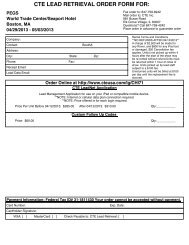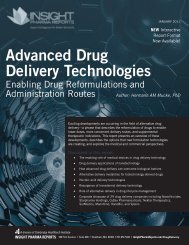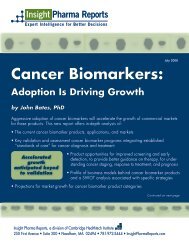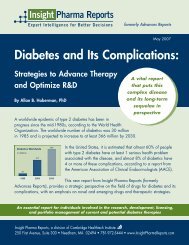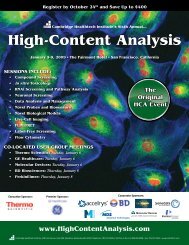2010 Best Practices Competition IT & Informatics HPC
IT Informatics - Cambridge Healthtech Institute
IT Informatics - Cambridge Healthtech Institute
- No tags were found...
Create successful ePaper yourself
Turn your PDF publications into a flip-book with our unique Google optimized e-Paper software.
Published Resources for the Life Sciences<br />
250 First Avenue, Suite 300, Needham, MA 02494 | phone: 781‐972‐5400 | fax: 781‐972‐5425<br />
exploits the fact that, once written, cell level data is unlikely to change. Partitioning the<br />
tables in a coordinated fashion provided 10-fold reductions in data load times and 20-fold<br />
reductions in query times. Historical partitions are accessed in read-only mode which<br />
helps to protect data integrity and speeds up database backup and recovery.<br />
Experimental annotation<br />
HCS Road captures information on experimental treatments and conditions in a way that<br />
enables long-term mining of results across assays and users and enforces consistent<br />
nomenclature for cell lines, detection reagents, and control or experimental treatments.<br />
Figure 2 shows the workflow for assay definition, treatment selection, and data import and<br />
analysis. Much of this information is referenced or imported from other databases. Thus,<br />
HCS Road imports or references treatment information such as compound structures,<br />
RNAi targets and sequences, and library plate from existing enterprise databases (green<br />
box in Fig. 2). Similarly, cell line information is linked to an enterprise registry that tracks<br />
information on source, tissue type, transgenic constructs, passages and other relevant<br />
information. This reduces the data entry burden on users, reduces errors, and ensures<br />
consistency within HCS Road and with data from other platforms. Annotation that cannot<br />
be imported or referenced is stored in the Road database. For example, information on<br />
fluorescent probes including probe name, vendor and catalog number, fluorescent<br />
characteristics and molecular or cellular targets is stored within HCS Road in a way that<br />
supports re-use across multiple assays.<br />
The creation of a new assay begins with the selection of the cell line(s) and fluorescent<br />
probes used in an experiment (yellow box in Fig. 2). Control and reference compounds<br />
can be selected from the reagent registry or entered manually (as for commercially<br />
purchased reagents). Business metadata is also collected to enable reports of results<br />
across multiple assays and to support data retention decisions. Next, one or more ‘master’<br />
plates are created with information on cell seeding along with locations and concentrations<br />
of control and reference treatments and fluorescent probes. HCS Road supports multiple<br />
plate layouts including 96, 384 and 1536-well; additional custom layouts can be quickly<br />
defined as needed. Finally, multiple copies of this master plate are created to correspond<br />
to the physical plates in the assay. Reagents tested in the assay can be entered manually<br />
(as during assay development) or automatically from existing reagent databases (green<br />
box in Fig. 2). Assays and plates can also be copied to streamline small changes to<br />
experimental designs or plate layouts.<br />
The last step in experimental annotation is the assignment of positive and negative control<br />
treatments (blue box in Fig. 2). Different treatments can be designated as positive and<br />
negative controls for different measurements. This provides the flexibility needed to



